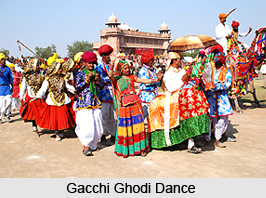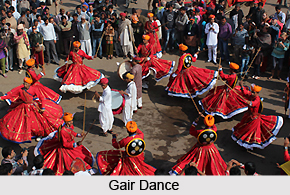 Culture of Sirohi district as of any other place, is contained in the art, literature, music etc which are passed down to be practised and forwarded down the generations. These art forms are typical to a place, and the district of Sirohi too has a number of dances, music, paintings and theatrical performance that have originated and been followed in the district over the ages.
Culture of Sirohi district as of any other place, is contained in the art, literature, music etc which are passed down to be practised and forwarded down the generations. These art forms are typical to a place, and the district of Sirohi too has a number of dances, music, paintings and theatrical performance that have originated and been followed in the district over the ages.
Folk Songs and Dances of Sirohi District
Folk Songs and Folk dances are the traditional way of amusement and entertainment of the people of Sirohi. These traditional songs are full of classical melody and are based on Ragas. The tribals and people residing in rural areas are fond of singing folk songs and performing the folk dances on the occasion of festivals, fairs, marriages and religious occasions etc. These folk songs and dances express a variety of feelings and emotions, such as love for the beloved, affections between brothers and sisters, sorrow and pain etc. Some of the examples of the marriage folk songs are Mayra Song, song sung for the bride/ bridegroom called songs of Banada and song of Toran. The Mayra is sung when the brother arrives to his sister`s house for attending his nephew`s marriage, and it expresses the feelings of the sister for her brother. The Toran Song is sung when the Bride arrives to the bridegroom`s house with the barat or procession and reaches the gate of the house of the bridegroom. On the fortnight of the marriage, a special type of folk song and dance is organised called the Marat Nachna. The men and women perform solo and group dances till late at might. On this occasion, Sarkali and Gavri dance are also performed. The traditional drum and Thali are used as musical instruments.
Gair dance is performed in the month of Falgun and on the Holi festival. Tribal women perform Valar dances wearing colourful costumes which look very attractive.
On the occasion of the Dhajeri Gyaras fair organised in the Sarneshwar Temple, men and women of the Rabbari caste sing and dance the whole day long. This festival is only for the people of the Rabbari caste, and they are required to wear their traditional costumes on this day. At night the women sing and the men watch the dance of Oriya, a folk dancer from the Kheda caste who performs dances on these occasions.
The Gacchi Ghodi dance is very attractive dance performed by the tribal people, in which a costume is worn by the man and it looks as if the man is sitting on a horse. On the occasion of the Navratri Festival, the Garba dance of Gujarat is performed. On this occasion the men and women wear colourful costumes and dance in a circle.
 Fair and Festivals of Sirohi District
Fair and Festivals of Sirohi District
Sirohi is surrounded and influenced by the traditional cultures of three places - Marwar, Mewar and Gujarat. Correspondingly, there are a number of colourful fairs and festivals celebrated here. In Pindwara and Aburoad Tehsil, fairs and festivals are organised at ancient temple sites and the tribals participate in large numbers with their traditional colourful dresses, ornaments and weapons. In such fairs the youth of the tribal community select their match while dancing with umbrellas and colourful handkerchiefs. These fairs are now organised at Gopeshwar 2 kms away from Pindwara towards Udaipur, Markandeshwar, Ajari, Siyava (Aburoad) and Rishikesh near Aburoad. Other fair sites are Lotana, Rameshwar, Kedarnath, Amli, Valoriya, Vasanthgarh.
Some of the major fairs and festivals of the district are:
Gautam Ji - Chautila Hill - This fair is of Mina community which is devoted to Gautam Rishi, a God of this community. The occasion is celebrated on 13th April of every year.
Kambeshwar Mahadev - Located on Kanakolar hill (Sheoganj Tehsil). The fair is organized by people and dedicated to Lord Shiva.
Vambeshwar Mahadev - Jadoli Veer (Sheoganj Tehsil)
Jagnath Fair - Organized at Sheoganj town
Pabuji Fair - On the river bed of Jawai
Bhuteshwar Fair - At village Bhutgaon
Sarneshwar Fair - Near Sirohi
Sheetla Mata Fair - Sirohi Town
Jiravala Parshavnath Fair - At Jiraval
Karrodidwaj Fair - At Karrodidwaj village
Apart from this, the culture of Sirohi district is reflected in the beautiful paintings that are found here in the district. Sirohi style of painting is inclined more towards folk. It includes Marwar and Mewar influences along with Mughal fashion which was rather mixed in Rajasthani culture. Sirohi paintings are mainly available in two sizes. One is manuscript paintings, very small in size, and the other is wall paintings. Colours of Sirohi paintings are bright and pure, and the use of blue in its various tones is peculiar in Sirohi.
The culture of Sirohi district is thus reflected in these various art forms present and popular in the district.



















